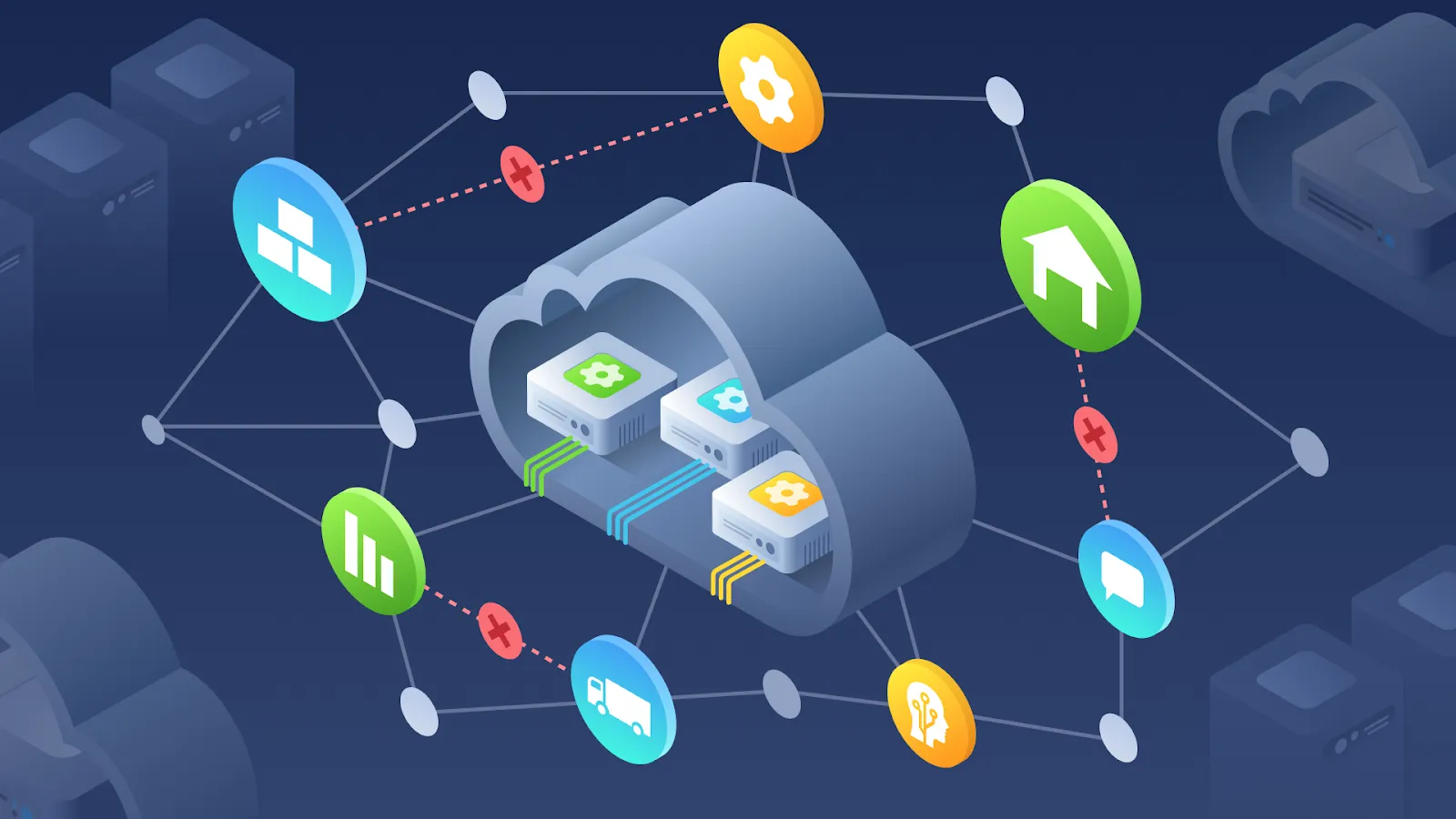During the last decade, the process of managing servers has transformed from a full-time job that requires organizations to curate systems and ensure smooth workflows, along with other stable operations, into almost full automation that allows companies to manage critical cloud-based infrastructures.
The particular shift has not happened in one moment. But there are still many businesses that think they have missed a chance and now feel scared of migrating to a cloud-based infrastructure through a cloud enablement process. Also, they consider deploying the DevOps model of app development automation as too complicated to implement.
So there is a need to break the existing misconception and provide executives with a better understanding of such new approaches since workflow automation and the ability to run multiple servers for accomplishing key business goals is not the advantage of some lucky ones.
In this case, we should learn more about the core - Infrastructure as Code (or IaC). But before we analyze the top reasons to invest in IaC and its best practices, we need to define the nature of this approach and explain how it works. That will help address why the IaC model has come to be in the first place.
What is Infrastructure as Code?
Infrastructure as Code serves as an automated type of infrastructure management. This model uses a descriptive manner for approaching networks, virtual machines (VMs), load balances, or connection topology thanks to versioning. That makes it quite similar to DevOps tackling source code. Like the particular source code that can generate the same binary, the IAC model implements the same principle since it creates the same environment during every execution.
Essentially, IAC is a model that can codify everything.
The IAC approach includes engineers who define the computer systems necessary to run by their codes. In most cases, they apply a specific framework such as Chef, Ansible, or Puppet for defining the system’s infrastructure.
Managing web applications is among the most typical use cases for IaC libraries. That is because modern apps are considered complex entities that always need load balancers, one (or a few) web servers, database servers, efficient queue processing systems, and so on.
Using legacy systems requires administrators to conduct provisioning and manage all the relevant interlocking systems and processes manually. Such an approach needs time, resources, along specific skills. On the other hand, the IaC approach cuts down all the time-consuming tasks to several minutes with automation.
After the engineers identify the building blocks necessary for their project, the IaC framework will perform all the heavy lifting for creating and shaping the infrastructure appropriately.
That can be done since the IaC model:
- provisions virtual servers;
- installs software packages;
- creates users;
- starts code processes, etc.
Among the most popular IaC tools are the following: Terraform, AWS CDK, AWS CloudFormation, Azure Resource Manager, and Puppet. The first one is probably the most widely used. For example, Terraform supports several biggest cloud providers, including AWS, Microsoft Azure, and Google Cloud Platform.
How Infrastructure as Code works
Basically, the IaC procedure involves the three major steps:
- The developers define and write the infrastructure specifications in a domain-specific language or by using one of the general application popular programming languages.
- After creating files, they are sent to a management API (application programming interface), master server, or a relevant code repository.
- Then, the platform performs all the required actions for creating and configuring the computing resources.
All modules will create the appropriate IaC environment depending on their needs and specifications. Thus, there are two key structure types where these environments can perform: declarative and imperative. While the declarative structure determines the components to install and the systems to exist, the imperative one identifies how to configure the environment accordingly.
Although it relies on the industry and the company itself, most organizations prefer the declarative approach. But let’s analyze the difference between them.
The declarative approach (also called functional) requires you to specify how you want to configure the final state of the provisioned infrastructure. After that, the IaC software conducts all the heavy lifting such as spinning up VMs/containers, installing/configuring software, taking care of system/software interdependencies, managing versioning, etc. To apply this approach, you should have an experienced admin who can set up and manage the entire procedure.
What about the imperative approach (also called procedural) - it requires preparing automation scripts that allow tackling your infrastructure provisioning one particular step at a time. In turn, applying this solution also needs more management activities, especially in terms of scaling. But this approach is much easier since it provides admins with an opportunity to understand configuration scripts correctly and thus unleash their full potential.
Top-7 reasons to invest in IaC
The most critical benefits of investing in Infrastructure as Code are the following:
Faster time to market
Thanks to deploying IaC, the level of automation will promote a significant increase in workflow streamlining. Besides, the speed of the infrastructure provisioning process will also increase during the main stages that include development, testing, and production. Applying IaC will also shorten the time necessary for scaling and/or removing production infrastructure if needed.
With the ability to codify and document all the elements, the IaC approach will bring advantages, such as faster and fully automated provisioning of traditional infrastructures. In the other case, the particular process would involve lots of various time-consuming tasks.
Improved consistency
Improved consistency serves as an advantage derived from the “configuration drift” problem. This issue can result in mismatched development, test, and/or deployment environments because of specific changes and updates in ad-hoc configuration. Moreover, the “configuration drift” can further affect the deployment process and provoke security-related risks during the app and service development. That may be precisely vulnerable to projects that must follow strict regulatory compliance standards.
The IaC model benefits organizations by eliminating drift as it provides the same environment every time, which enables improved infrastructure consistency on an ongoing basis.
More effective development
Development automation through IaC and DevOps approach allows for a more simple provisioning process. That also makes the software delivery lifecycle’s stages more consistent and more accelerated.
IaC and DevOps make it possible for the development team to provide sandboxes much faster thanks to the Continuous Integration (CI) and Continuous Deployment (CD) environments. In addition, Quality Assurance provides full-fidelity test environments faster, when the operations also provide the environment required for security and user-acceptance testing more quickly. After completing the code testing successfully, you can deploy the app in a single step. That is similar to the production infrastructure where this app is running on.
Churn mitigation
IaC, along with the DevOps model, helps businesses make sure that provisioning-based intelligence and data stay at the organization. In companies that have not applied IaC, all the provisioning-related functions are traditionally conducted by skilled and experienced engineers. But this approach is not the bullet-proof one since it can result in numerous difficulties regarding the architecture reconstruction when the IT staff members leave their job.
Reduced costs and better ROI
Probably the most critical IaC benefit is the combination of cost reduction and the increase in Return on Investment (ROI). It means that utilizing Infrastructure as Code not only cuts down the amount of effort, time, or specialized experiences required for successful maintenance and scaling. Besides, it allows companies to unleash the cost-reduction potential provided by a scalable consumption-based cost structure.
Enhanced security
If applied correctly, the IaC-based infrastructure will enhance the entire security of the computing architecture and the information your organization stores within it. Also, it cares about misconfigured IaC files during the development process and, at the same time, changes the run-time security problems into build-time governance. However, it does so only in the case of being:
- automated;
- delivered as code;
- applied within a workflow that is continuous and consistent.
Increased workflow transparency
Workflow transparency serves as one of the most underestimated advantages of IaC successful implementation. Instead of throwing everything around diffusely through the Graphical User Interface (GUI), your workloads’ structural arrangement will become more organized and transparent. That will allow streamlining workflow better and increasing consistency.
What are the IaC best practices?
Although the IaC and DevOps concepts have already existed for some time, the number of organizations that could apply them successfully and with minimal hassle is small. If your company wants to develop the appropriate IaC strategy for its unique infrastructure, the key is to plan and find the optimal tactics.
Here we describe four IaC best practices that you can implement in your business:
Establish the “single source of truth”
Among the most widely used rules of thumb the one includes deploying code for describing your infrastructure everywhere and every time it is possible. In most cases, you will be recommended to codify both traditional and cloud infrastructures.
To codify physical/virtual server management, great tools to use are Terraform, YAML, Python, or CloudFormation. What about network management - you can perform it via Puppet/Chet modules, when container management is always conducted by using Docker. In the case of infrastructure specifications, our recommendation is to establish such configuration files as a relevant “single source of truth.”
Version control
All experienced IaC and DevOps engineers will agree that “version control everything” must be as critical as “codify everything.” Coding configuration files will make them version-controlled since you will gain an opportunity to track, manage, and restore all the potential changes smoothly. Also, version control can help diagnose the issues significantly. Today, you can use different tools available on the market that allow for efficient version control, change tracking, or source code management.
Documentation restriction
Since IaC provides code that may serve as the relevant documentation, you have to make sure to apply the code to reach a high level of consistency and clarity instead of executing it manually. That will reduce the possibility of human error and eliminate the need to conduct manual upgrades.
Use modularity and microservices
Microservices continue to take place among the most under-evaluated Infrastructure as Code advantages. But the development team can use the particular architectural style for developing, managing, and maintaining apps in the form of multiple deployable units. Besides, IaC enables developers to separate the infrastructure into numerous modular elements and then apply automation for combining them most fittingly.
Such an approach creates some valuable benefits, including:
- limitation regarding the configuration changes’ number;
- more accessibility control;
- effective dependency management.
Thus, when implemented appropriately, modularity acts as a glue that allows holding your whole infrastructure together.
The bottom line
Infrastructure as Code is increasing in popularity and becoming the norm for companies that look for automation and faster delivery. After all, developing apps at a faster path is only possible thanks to streamlining workflow and improving a development environment.
At the same time, selecting the right IaC solutions for your unique IT architecture may be quite a challenging task that requires sufficient resources and optimal guidance. However, once you establish your IaC environment correctly, you will start benefiting from the development process.




